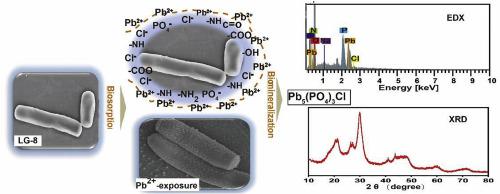Chemosphere ( IF 8.1 ) Pub Date : 2020-07-01 , DOI: 10.1016/j.chemosphere.2020.127507 Ling Meng 1 , Zhiyu Li 1 , Lizhi Liu 1 , Xiaohong Chen 1 , JunjunWu 1 , Wei Li 1 , Xuhui Zhang 2 , Mingsheng Dong 1

|
In this study, a yeast-like fungal strain (LG-8), newly isolated from spontaneous Tibet kefir in China, was identified as Geotrichum candidum on the basis of its morphological characteristics and ITS5.8S gene sequence. Interestingly, the strain was able to remove more than 99% of Pb2+ ions in water at low concentrations and a maximum of 325.68 mg lead/g of dry biomass. The results of selective passivation experiments suggested that phosphate, amide and carboxyl groups on the cell wall contributed to lead removal. Scanning electron microscopy (SEM) photomicrographs revealed that large amounts of micro/nanoparticles formed on the cell wall, and energy dispersive X-ray spectroscopy (EDX) results further indicated the presence of lead along with phosphorus and chlorine in the particles. Furthermore, the results of Fourier transform infrared spectroscopy (FTIR) and X-ray diffraction (XRD) analyses revealed that the particles were composed of pyromorphite [Pb5(PO4)3Cl], a highly insoluble lead mineral. Importantly, this is the first time that the biomineralization of lead into pyromorphite has been observed as the major mechanism for lead removal by G. candidum LG-8, providing a new strategy to scavenge heavy metals from aquatic environment in an eco-friendly manner.











































 京公网安备 11010802027423号
京公网安备 11010802027423号